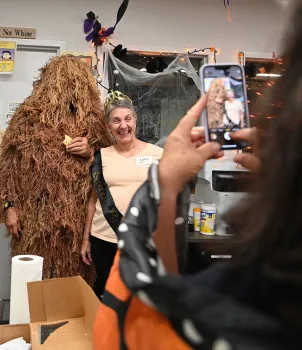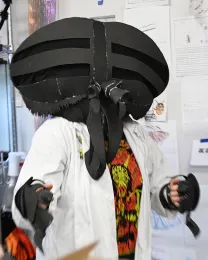
They all socialized and enjoyed a buffet dinner, followed by a cake. No predation! The occasion: the Bohart Museum's annual pre-Halloween party, hosted by the Bohart Museum Society.
- The queen bee: UC Davis distinguished professor Lynn Kimsey, director of the Bohart Museum
- The praying mantis: Tabatha Yang, education and outreach coordinator of the Bohart Museum
- The green darner dragonfly: Christofer Brothers, a UC Davis doctoral candidate researching dragonflies
- The monarch: Barbara Heinsch, a Bohart Museum volunteer, who arrived with her entomologist-husband, Mike Pitcairn, retired senior environmental scientist, supervisor, California Department of Food and Agriculture (CDFA). He wore his CDFA lab coat and swung an insect net.
UC Davis entomology alumna Ivana Li, a biology lab manager at UC Davis, catered the event and arrived with her dog, Juniper, dressed as a taco. Lynn Kimsey cut a carrot cake, decorated with tiny carrots and large googly eyes. Forensic entomologist Robert "Bob" Kimsey, dressed in his ghillie suit, served beverages.
Some attendees, including Joanna Chiu, professor and chair of the Department of Entomology and Nematology; UC Davis doctoral alumna Fran Keller, professor at Folsom Lake College; Bohart Museum associate Greg Karofelas; UC Davis doctoral alumnus Dick Meyer (who studied with the late Richard Bohart); and entomology student Kaitai Liu, arrived as themselves, sans Halloween costumes.
Background. The Bohart Museum, located in Room 1124 of the Academic Surge Building, 455 Crocker Lane, houses a global collection of eight million insect specimens, plus a live insect petting zoo and a gift shop. Founded in 1946 by the late UC Davis professor Richard Bohart, it has been directed by Kimsey, his former doctoral student, since 1990.

A recognized authority on insect biodiversity, systematics and biogeography of parasitic wasps, urban entomology, civil forensic entomology, and arthropod-related industrial hygiene, Kimsey is a 34-year member of the UC Davis entomology faculty and a UC Davis alumna, holding bachelor and doctoral degrees in entomology.
When former department chair Richard Bohart (for whom the museum is named), founded the museum in 1946, it was a “hole in the wall” in Briggs Hall that included only 400 insect specimens. Under Kimsey's tenure, it has grown to a global collection of eight million insect specimens and is the seventh largest insect collection in North America.
The Bohart draws an average of 15,000 visitors a year, adds an average of 30,000 new specimens annually, and loans an average 7000 specimens yearly to scientists worldwide. It supports campus classes with specimens, live insects and exhibits in keeping with its mission: “Understanding, documenting and communicating terrestrial arthropod diversity.”

